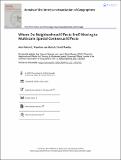Files in this item
Where do neighborhood effects end? Moving to multiscale spatial contextual effects
Item metadata
| dc.contributor.author | Petrović, Ana | |
| dc.contributor.author | van Ham, Maarten | |
| dc.contributor.author | Manley, David John | |
| dc.date.accessioned | 2021-06-25T11:30:03Z | |
| dc.date.available | 2021-06-25T11:30:03Z | |
| dc.date.issued | 2021-06-22 | |
| dc.identifier | 273004733 | |
| dc.identifier | 6ee31786-8050-4fa4-b1a4-60859a90e28b | |
| dc.identifier | 000664382100001 | |
| dc.identifier | 85108254226 | |
| dc.identifier.citation | Petrović , A , van Ham , M & Manley , D J 2021 , ' Where do neighborhood effects end? Moving to multiscale spatial contextual effects ' , Annals of the American Association of Geographers , vol. Latest Articles . https://doi.org/10.1080/24694452.2021.1923455 | en |
| dc.identifier.issn | 2469-4452 | |
| dc.identifier.other | ORCID: /0000-0002-2106-0702/work/96141175 | |
| dc.identifier.uri | https://hdl.handle.net/10023/23421 | |
| dc.description | Funding: European Research Council under the European Union's Seventh Framework Programme (FP/2007-2013) / ERC Grant Agreement n. 615159 (ERC Consolidator Grant DEPRIVEDHOODS, Socio-spatial inequality, deprived neighbourhoods, and neighbourhood effects) and from the Marie Curie programme under the European Union's Seventh Framework Programme (FP/2007-2013) / Career Integration Grant n. PCIG10-GA-2011-303728 (CIG Grant NBHCHOICE, Neighbourhood choice, neighbourhood sorting, and neighbourhood effects). | en |
| dc.description.abstract | There is no theoretical reason to assume that neighborhood effects operate at a constant single spatial scale across multiple urban settings or over different periods of time. Despite this, many studies use large, single-scale, predefined spatial units as proxies for neighborhoods. Recently, the use of bespoke neighborhoods has challenged the predominant approach to neighborhood as a single static unit. This article argues that we need to move away from neighborhood effects and study multiscale context effects. The article systematically examines how estimates of spatial contextual effects vary when altering the spatial scale of context, how this translates across urban space, and what the consequences are when using an inappropriate scale, in the absence of theory. Using individual-level geocoded data from The Netherlands, we created 101 bespoke areas around each individual. We ran 101 models of personal income to examine the effect of living in a low-income spatial context, focusing on four distinct regions. We found that contextual effects vary over both scales and urban settings, with the largest effects not necessarily present at the smallest spatial scale. Ultimately, the magnitude of contextual effects is determined by various spatial processes, along with the variability in urban structure. Therefore, using an inappropriate spatial scale can considerably bias (upward or downward) spatial context effects. | |
| dc.format.extent | 22 | |
| dc.format.extent | 2345208 | |
| dc.language.iso | eng | |
| dc.relation.ispartof | Annals of the American Association of Geographers | en |
| dc.subject | Neighbourhood effects | en |
| dc.subject | Spatial scale | en |
| dc.subject | Bespoke neighbourhoods | en |
| dc.subject | Distance decay | en |
| dc.subject | Socioeconomic status | en |
| dc.subject | GF Human ecology. Anthropogeography | en |
| dc.subject | HN Social history and conditions. Social problems. Social reform | en |
| dc.subject | 3rd-DAS | en |
| dc.subject.lcc | GF | en |
| dc.subject.lcc | HN | en |
| dc.title | Where do neighborhood effects end? Moving to multiscale spatial contextual effects | en |
| dc.type | Journal article | en |
| dc.contributor.sponsor | European Research Council | en |
| dc.contributor.institution | University of St Andrews. Population and Health Research | en |
| dc.contributor.institution | University of St Andrews. School of Geography & Sustainable Development | en |
| dc.identifier.doi | 10.1080/24694452.2021.1923455 | |
| dc.description.status | Peer reviewed | en |
| dc.identifier.grantnumber | ERC-2013-CoG | en |
This item appears in the following Collection(s)
Items in the St Andrews Research Repository are protected by copyright, with all rights reserved, unless otherwise indicated.

